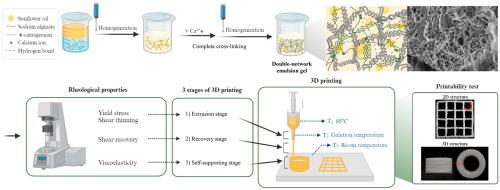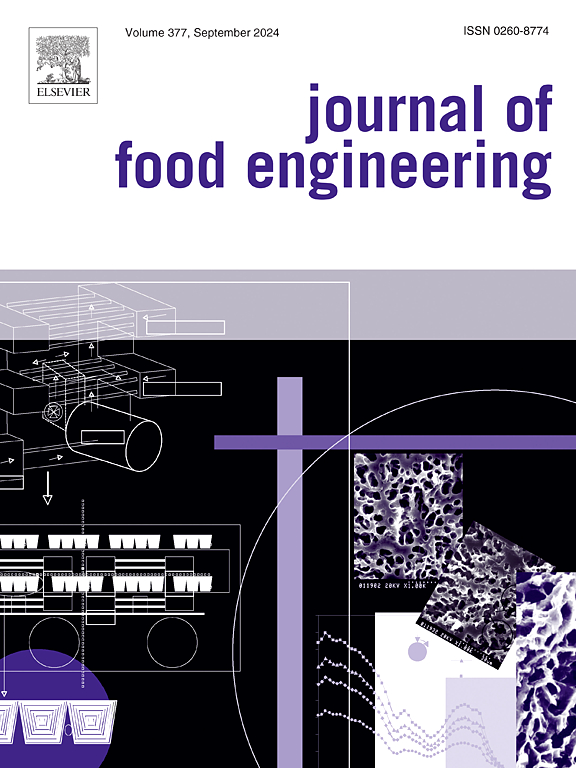模拟牛脂肪组织的双网状乳液凝胶的制备及其在3D打印油墨中的应用
IF 5.8
2区 农林科学
Q1 ENGINEERING, CHEMICAL
引用次数: 0
摘要
开发能够有效模仿动物脂肪组织的脂肪替代品对于提高植物性肉类的质量和支持可持续粮食生产至关重要。本研究介绍了一种由海藻酸钠和κ-卡拉胶组成的3d打印乳液凝胶,旨在复制真实动物脂肪的结构和热性能。以不同浓度的κ-卡拉胶(0%、1%、2%、3%)配制乳液凝胶,并通过扫描电镜(SEM)、CLSM、红外光谱(FTIR)和流变学分析对其理化特性进行评价。随着κ-卡拉胶浓度的增加,凝胶的微观结构更致密,油滴尺寸更小,网状结构更强。这些变化增强了热稳定性,3% κ-卡拉胶样品在80°c以上表现出逐渐融化的行为,与烹饪过程中牛脂肪组织的热反应非常相似。为了评估可打印性,研究人员对基于挤压的3D食品打印的流变参数进行了三个工艺阶段的分析:挤压(粘度、屈服应力)、恢复(3ITT)和自支撑(频率扫描)。胶凝温度随κ-卡拉胶含量的增加而升高,这表明每种配方的最佳印刷温度必须有所不同。2D和3D打印试验证实,将打印温度与凝胶点相匹配是实现精确沉积和形状保真度的关键。总的来说,这些发现突出了所提出的乳液凝胶体系的潜力,通过密切模仿动物脂肪的结构和热行为来提高植物性肉类类似物的质量,同时也为优化用水胶体配制的脂质食品的3D打印性提供了实用的见解。本文章由计算机程序翻译,如有差异,请以英文原文为准。

Fabrication of double-network emulsion gels to emulate bovine adipose tissue and application in 3D printing ink
Developing fat alternatives that can effectively mimic animal adipose tissue is crucial for enhancing the quality of plant-based meat and supporting sustainable food production. This study introduces a 3D-printable emulsion gel composed of sodium alginate and κ-carrageenan, designed to replicate the structural and thermal properties of real animal fat. Emulsion gels were formulated with varying concentrations of κ-carrageenan (0 %, 1 %, 2 %, 3 %), and their physicochemical characteristics were evaluated using SEM, CLSM, FTIR, and rheological analysis. As the κ-carrageenan concentration increased, the gels exhibited denser microstructures, smaller oil droplet sizes, and stronger network formation. These changes enhanced thermal stability, with the 3 % κ-carrageenan sample demonstrating a gradual melting behavior above 80 °C—closely resembling the thermal response of bovine adipose tissue during cooking. To assess printability, rheological parameters critical to extrusion-based 3D food printing were analyzed across three process stages: extrusion (viscosity, yield stress), recovery (3ITT), and self-support (frequency sweep). The gelation temperature increased with κ-carrageenan content, indicating that optimal printing temperatures must be tailored to each formulation. 2D and 3D printing trials confirmed that matching printing temperature to the gelation point was key to achieving accurate deposition and shape fidelity. Overall, these findings highlight the potential of the proposed emulsion gel system to enhance the quality of plant-based meat analogues by closely mimicking the structural and thermal behaviors of animal fat, while also offering practical insights into optimizing the 3D printability of lipid-based foods formulated with hydrocolloids.
求助全文
通过发布文献求助,成功后即可免费获取论文全文。
去求助
来源期刊

Journal of Food Engineering
工程技术-工程:化工
CiteScore
11.80
自引率
5.50%
发文量
275
审稿时长
24 days
期刊介绍:
The journal publishes original research and review papers on any subject at the interface between food and engineering, particularly those of relevance to industry, including:
Engineering properties of foods, food physics and physical chemistry; processing, measurement, control, packaging, storage and distribution; engineering aspects of the design and production of novel foods and of food service and catering; design and operation of food processes, plant and equipment; economics of food engineering, including the economics of alternative processes.
Accounts of food engineering achievements are of particular value.
 求助内容:
求助内容: 应助结果提醒方式:
应助结果提醒方式:


